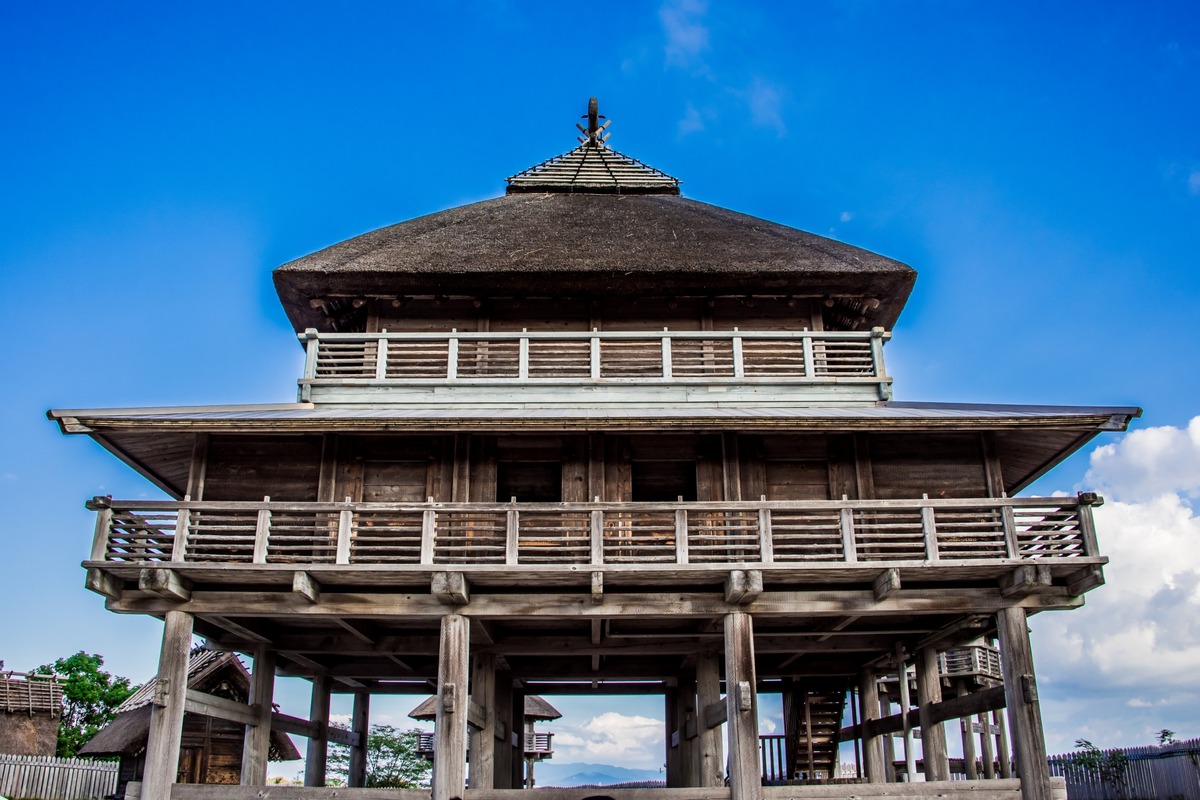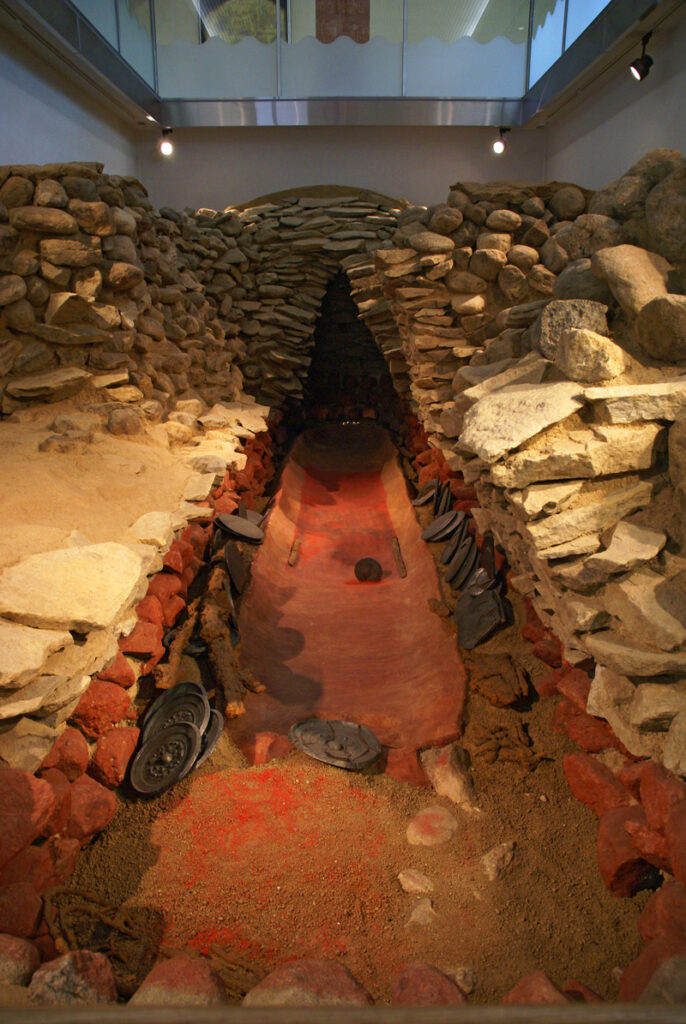Yamataikoku – Japan’s lost kingdom
Close to 2,000 years ago, China left Japan with one of the most complicated jigsaw puzzles of all time. Most of the pieces are missing, the visible parts of the picture are ambiguous, and there are no clues whatsoever as to how the pieces fit together. Some of those pieces may even belong to a different puzzle entirely! The puzzle’s name is ‘Yamataikoku’. Japan has been trying to force the pieces together for the last 300 years.
In the third century, the mass of land that now comprises China was split into three states: Wei(魏), Shuhan(蜀 ) and Wu(呉 ). These states were at war for almost sixty years, and the story of their war was recorded in a text called ‘The Records of the Three Kingdoms'(or ‘Sangokushi'(三国志) in Japanese). The part of the text written by Wei is known as ‘Gisho'(魏書), and it is the most comprehensive of the few texts in existence that contain documented history of Japan from the 2nd – 5th centuries.
The parts pertaining to Japan were compiled into a chronicle that became known as ‘Gishi Wajinden'(魏志倭人伝). This is where we find the puzzle of Yamataikoku. The information is incomplete, ambiguous and confusing, but it is all researchers have to go on to unwrap the mystery of Japan’s late Yayoi era. Let’s start by taking a look at the information.
Gishi Wajinden
The Wajinden refers to Japan as ‘Wa’. The Chinese character chosen to represent the name is ‘倭’, which, in Chinese, can mean either ‘short, dwarf-like people’ or ‘subservient’. However you interpret this, it’s beyond evident that Wei looked down on Japan. Interestingly, in the 8th century, when Emperor Tenmu changed the country’s name to ‘Nippon'(日本), he also changed the ‘wa’ character to ‘和’, which means ‘peace’ or ‘harmony’. This character is still used in expressions such as ‘washoku'(和食), Japanese food; and ‘waka'(和歌), Japanese poetry. The term ‘wagyū’, Japanese beef, has also been popularised recently. Before I digress too far into this study of ancient etymology though, let’s get back to the Wajinden.
Establishment of Yamataikoku

The text’s first mention of Japan is in the year AD 57, where it speaks of a ruler who sent an envoy to Eastern Han―one of the dynasties that controlled China before the Three Kingdoms period. It then skips 50 years and goes on to mention a ruler named Suishō in the year 107. 70-80 years later, a war broke out in Wa that lasted eight years before a female ruler named Himiko was chosen to unite the warring lands. She was aged, unmarried and had sorceress-like powers that bewitched the people.
Himiko had 1,000 female servants and one male servant, who prepared her meals and acted as a kind of butler. Her palace was surrounded by a steep fence and watchtowers, which were protected by guards at all times. After becoming ruler of Yamataikoku, Himiko was rarely seen in public. She spent her days within the walls of her palace creating premonitions and making weather predictions, which her brother reported to the people. Researchers have varying opinions regarding the nature of Himiko’s ‘powers’. Some believe they were shamanistic in nature while others believe they were early Shintō rituals. Whatever form they took, Himiko’s ‘premonitions’ were most likely a combination of meteorological proficiency and an ability to read people. In those days, however, it was easier to convince the general populace if you claimed your predictions were premonitions from the gods.

Shingi Waō
In the year 239, Himiko sent messengers to Wei with offerings of four male slaves, six female slaves and a number of beautifully designed cotton cloths. The emperor was so delighted, he sent back 100 bronze mirrors and a golden seal with the phrase ‘Shingi Waō'(親魏倭王) carved out in it. This translates more or less to ‘friend of Wei, ruler of Wa,’ and was intended by the emperor for Himiko to use on any official documents sent from Wa from that point on.
Yamataikoku’s relationship with Wei went from strength to strength, with the emperor sending messengers the following year declaring Himiko the official ruler of Wa, and Himiko returning the favour three years later with more slaves and fabrics. In 247, Himiko sent one final correspondence to Wei, stating that she was at war with Kunukoku―a country to the south of Yamataikoku. She died the following year. Details in the Wajinden following her death continue to be frustratingly vague, mentioning only that shortly after Himiko died, a man became king, but war broke out across Wa and 1,000 people died. Eventually, Toyo(or possibly Iyo), a relative of Himiko, was chosen to be the new ruler. She took over Yamataikoku and reunited the countries at the age of thirteen.
After the war, Toyo sent an offering of 30 slaves, 5,000 pearls, two jade magatama beads and 20 silk fabrics to the emperor. A burial mound 100 steps in perimeter was built for Himiko, and 100 slaves were sealed in the burial chamber as sacrifices. After that, Wa disappeared from Chinese history for almost 150 years.
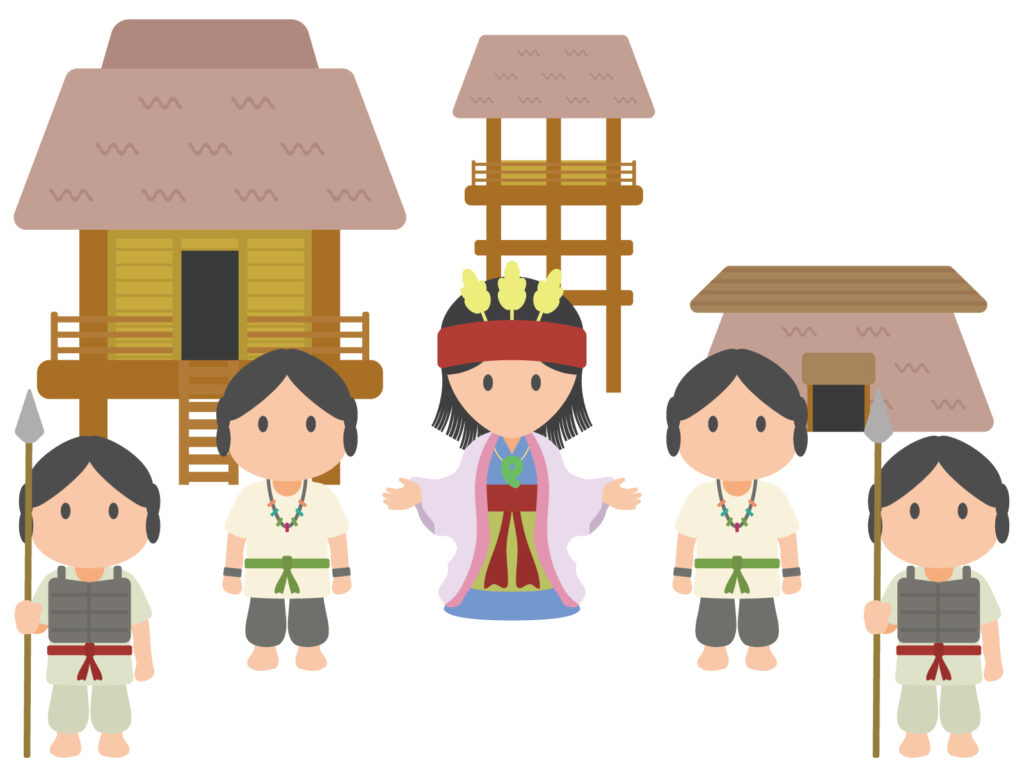
Yamataikoku
Now that you’re hopefully familiar with the history of Yamataikoku, let’s take a look at it from a societal and cultural perspective. Once again, the Wajinden is more or less the sole source of information on this topic.
Demographics
Yamataikoku was the largest of 31 countries mentioned in the Wajinden, containing 70,000 households. Both slave labour and taxes existed in Wa, the tax offices located in Itokoku to the north of Yamataikoku. Each country that belonged to the Yamaitatoku union contained a large warehouse where each household’s tax was stored for the year.
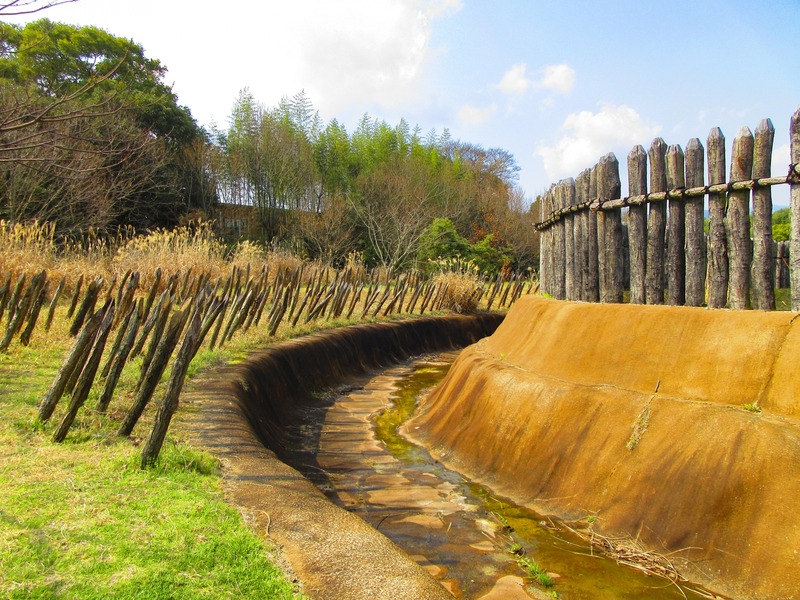
Appearance
Men had tattoos on their faces and bodies, the designs of which denoted their status and area of origin. People also seemed to like painting their bodies with red powder for reasons unknown. Men tied their hair into buns, while women wore their hair down.
Lifestyle and diet
Families lived together in pit dwellings. Each member had their own sleeping area. They served food on dishes but ate using their hands. Their diet consisted mainly of rice and raw vegetables. They hunted for meat but didn’t raise livestock. They raised silkworms, whose threads they used to create silk robes, which were worn by the elite. Daily use clothes worn by commoners were made from plants such as hemp. The clothes themselves consisted of two pieces of cloth sewn together at the sides, with a hole left in the top for the wearer to put their head through. Since the ground was warm, they didn’t need to wear shoes.
Weapons
They used weapons such as spears, shields and bows, all made from wood. Arrows were made by attaching arrowheads made from bronze, iron or small animal bones to lengths of thin bamboo. They also used animal bones for a fortune-telling ritual, whereby a shaman would burn the bone and predict the future based on the cracks that formed on the bone’s surface.
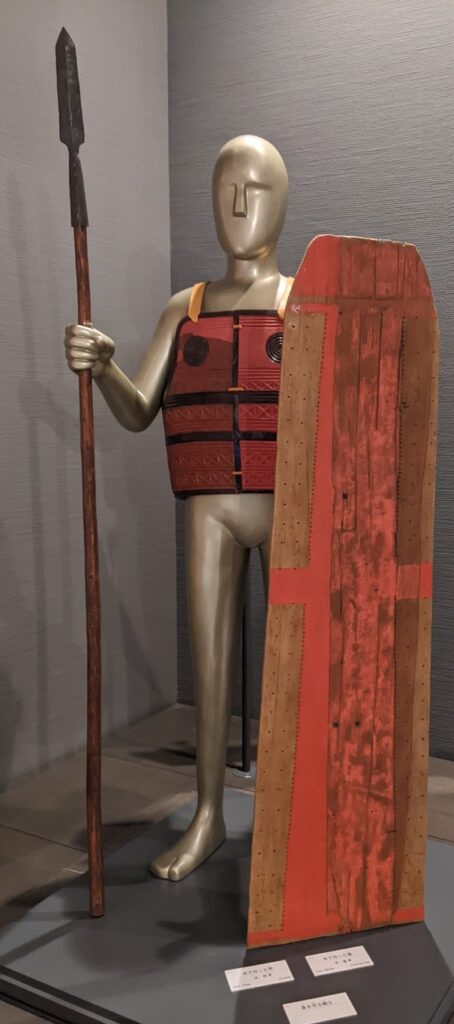
Rituals
People were highly superstitious and ritualistic. When a person died, villagers performed ritualistic screams that lasted for ten days. While mourning, they abstained from eating meat. Funerals involved alcohol, singing and dancing. After burying the body, all involved would bathe themselves in cold water to purify their bodies.
When embarking on a dangerous overseas journey, a person was chosen for a role known as ‘jisai’. The jisai’s job was to remain on the ship throughout the voyage and absorb any negative forces that may cause disasters to occur to the ship(a kind of supernatural lightning rod). During that time, they were forbidden to bathe, wash their clothes or consume meat. If the ship returned safely, they were rewarded handsomely. If disaster befell the ship, they were punished, or, in severe cases, killed.
Society
At social gatherings, everyone was treated equally; there was no etiquette based on age or gender, and men and women of all ages enjoyed drinking alcohol. To show respect, people would clap, crouch, or place their hands together. They apparently had a long life expectancy, with some people living to be over 100 years of age. High-ranking members of society could have up to five wives while lower-ranking members could have two or three wives. There was no theft and very few legal cases. For a minor transgression, a man would have his wife and children taken from him. For a more severe crime, his family line would be ended.

As you can see, while the Wajinden gives a number of details regarding Yamataikoku’s society, it fails to give any specific examples or stories to help flesh them out. When you consider the fact that the man who wrote the text had never been to Yamataikoku himself and only had decades-old second/third-hand stories off which to base his report, it can’t really be helped. Still, if these details are true, when compared with the information available on similar cultures that existed at the time, they give us a fairly good idea of how people in Yamataikoku lived.
Location of Yamataikoku
Of all the many mysteries surrounding Yamataikoku, the one that plagues historians and archaeologists the most has to be its location. Figuring out where it was has proven to be an enigma-code-level riddle that’s baffled historians at the forefront of their field for the last 300 years. At the very least, they’ve managed to narrow the location down to two regions(or at least most of them have. There are still a few who insist on more minor theories). The most plausible locations are Kansai and Kyūshū. While a fair amount of evidence exists to support each case, however, an equal amount of evidence also exists to denounce them.
Name
The first problem is the name ‘Yamataikoku’ itself. Take away the ‘koku’ part(which just means country), and you’re left with ‘Yamatai’, which, going by the characters used to represent it in the Wajinden, would have been pronounced ‘Jamadə’ in Chinese. When reverse translated to Japanese, you arrive at the pronunciation ‘Yamado’. However, as there is evidence to believe that at that time there was no distinction between the soft ‘d’ sound and the hard ‘t’ sound in the Japanese language, it’s equally possible the name was pronounced ‘Yamato’. This is the former name of both Nara prefecture and the court established in the 4th century which evolved into the imperial line that exists today.
So there you have it… Definitive proof. Yamataikoku was based in Nara and transitioned into the Yamato court, right? Maybe… Except for the fact that there’s an area in Northern Kyūshū called ‘Yamato’ as well! Clearly, the name can’t be relied on to give us the location. So how about the directions laid out in Chinese texts?
Directions
The Wajinden gives precise directions to get from the capital of Wei to Yamataikoku. However, the measurements change midway from the standard ancient Chinese measurement of distance―the li―to the more vague and ambiguous measurement of time. When followed to the letter, these directions lead you to the middle of the Pacific Ocean. Either someone jotted them down incorrectly or changed them for political reasons. It’s been the job of historians for centuries to try to reinterpret these directions.
To be fair, it’s likely the figures listed were exaggerated. The Gisho contains other examples of embellishments, such as multiplying army numbers by a factor of ten to give the impression the Wei army was much larger than it actually was. There’s solid evidence that backs this theory up too concerning the value of a li. Currently, one li measures approximately 2.5 miles. However, the value changed many times throughout history. During the Three Kingdoms period, it measured 500 yards. When this measurement is applied to the distances given in the Wajinden, however, Yamataikoku lands well outwith the borders of Japan.
This being the case, the commonly-accepted theory is that the real measurement is a version of the li known as the short li, which measures 80-100 yards. When tested against distances recorded in the Gisho between places whose locations have been confirmed, this measurement checks out. For example, the Wajinden states that the distance between Kuyakankoku and Tsukaikoku is 1,000 li. It also states that the distance between Tsukaikoku and Ikikoku is 1,000 li. The locations of these places are known today, and the distances between them in modern measurements is approximately 46 miles each. This strongly suggests that in the Wajinden, 1 li equates to a distance of 0.046 miles, or 80 yards.
The Kansai theory
Names and measurements aside, there are other compelling reasons to support the various theories regarding Yamataikoku’s location. Let’s take a look at some of the strongest evidence surrounding the Kansai theory.
Argument
To begin with, a kofun known as Hashihaka in Nara prefecture conforms more or less perfectly to the dimensions given in the Wajinden for Himiko’s tomb. Objects excavated from the tomb date back to the third century, backing up the evidence further. In addition, a number of bronze mirrors containing the date of the year in which Himiko sent messengers to Wei were found around various sites in Kansai. The Makimuku ruins, also in Nara, contain not only the largest latter-Yayoi settlement found in all of Japan but also a large number of objects believed to have been produced in various parts of the country, suggesting that the area was a centre of trade.
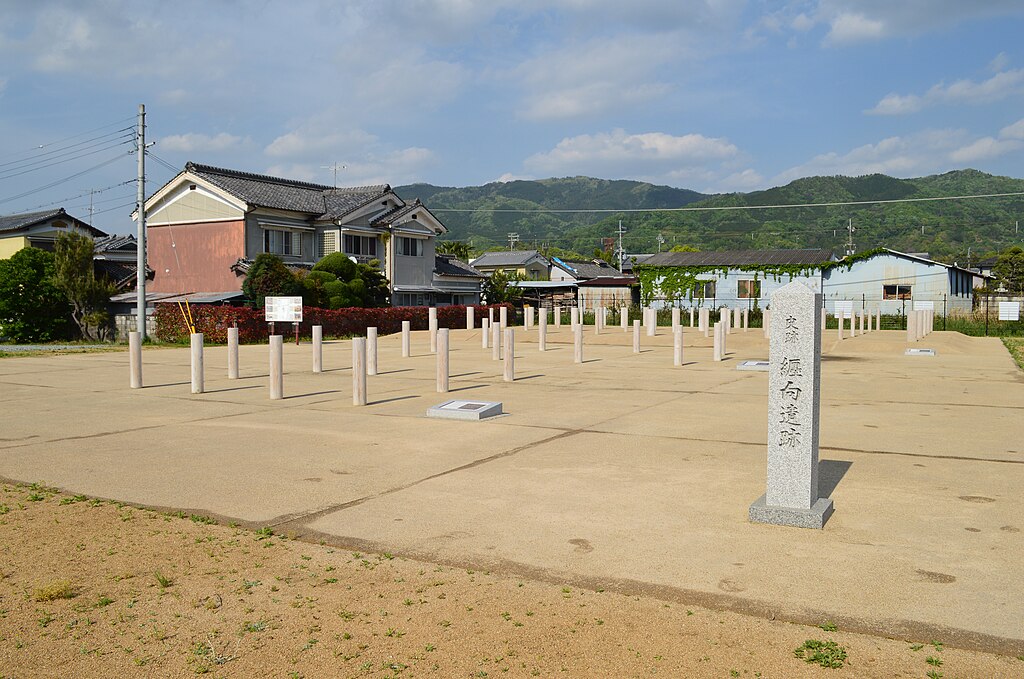

Rebuttal
Compelling as all this evidence may be, critics argue that even with the reinterpretation of the Wajinden’s measurements and directions, the numbers still aren’t large enough for Wei’s envoys to have reached Kansai. Also, while the theory assumes Hashihaka to be Himiko’s grave, there are no signs of the remains of the slaves that were supposedly buried with her.
Furthermore, while the bronze mirrors found in Kansai may be engraved with the Chinese year in which, presumably, they were produced, no similar mirrors have been found in either Korea or China. Experts in China who have studied the mirrors have even confirmed that they are not of Chinese origin. Also, while the Wajinden states that 100 bronze mirrors were sent to Himiko, over 500 have been excavated. This suggests that whatever the origin of these mirrors, it is unlikely that they are the same ones referred to in the text.
Perhaps the most compelling disparagement of the Kansai theory, however, is the fact that although the Wajinden contains mention of various countries to the north and south of Yamataikoku, it makes no mention whatsoever of Izumo or Kibi, two regions assumed to have been major powers at the time. If Yamataikoku was indeed based in Kansai, Wei’s envoys would have had to pass through both of these regions in order to get there. It is highly unlikely that they would pass through two regions with such huge influence without documenting them.
The Kyūshū theory
Subscribers to the Kyūshū theory are divided among two sub-theories. One states that Yamataikoku was established in Kyūshū and later moved to Kansai, evolving into the Yamato court. The other states that Yamataikoku was defeated by the Yamato court. Whichever the case, strong evidence exists that suggests Yamataikoku did, at some point, exist in Kyūshū.
Argument
To begin with, the Wajinden states that Yamataikoku is located to the south of Itokoku, a country which researchers agree is in the north of Kyūshū. The measurements detailed in the text also allow Yamataikoku to be placed in the north of Kyūshū, south of Itokoku. In addition, many remains of bodies found in the north of Kyūshū from the Yayoi era were buried in the manner described in the Wajinden.
One of the most interesting pieces of evidence, however, was the discovery of a golden seal sent to the king of Wa from the emperor of Han. The seal was unearthed by a farmer in Northern Kyūshū in 1784 and, although it isn’t directly related to Yamataikoku, it is likely that the king in question is one of the two rulers mentioned at the start of the Wajinden. Since the actions of these rulers eventually led to the formation of Yamataikoku, the existence of the seal tips the scales in favour of the Kyūshū theory.

Rebuttal
The Kyūshū theory too isn’t without its opposition though. The lack of artifacts found in tombs around Kyūshū and the lack of any tomb corresponding to the shape and size of Himiko’s work against the theory. In addition, the sizes of the settlements and villages discovered in Kyūshū pale in comparison to those found in Izumo or Kansai. Finally, while the golden seal seems to be pretty definitive evidence, its authenticity is impossible to confirm.
Conclusion
Without the discovery of new pieces to the puzzle of Yamataikoku or, at the very least, a guide to teach us how the pieces we have fit together, we may never solve the mystery of the legendary country’s location. Nevertheless, researchers and historians refuse to give up. The mystery is common knowledge to all Japanese people, and due to it having been adopted as the setting for the 2013 Tomb Raider game and 2018 Tomb Raider movie, it’s slowly starting to gain fame overseas. 300 years of research has taught us very little, but as technology and research methodology progress, the next 300 years may prove to be very fruitful.


